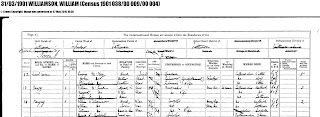Mary McLeod - 1828
Mary McLeod, the fourth child of John and Christina, was
born in Altnabreck and baptised 8 May 1828. Mary was named after her father’s
mother Mary McKay. Her birth is registered in the Halkirk parish but as with
her older siblings the baptism may have taken place at the Achreny Mission
church.
The McLeod family moved from Altnabreck to Rumsdale
sometime within a year or so of Mary’s birth so about 1829.
Census 1841 Rumsdale
The census of 1841 shows Mary the eldest child of the
McLeod family at home aged 12. Kitty, Donald and Betsy have gone already. There
are five children younger than Mary at home. I am sure she was in great demand
to help her mother with household chores. She is not shown as going to school
but the McLeod parents were strong on education so Mary probably had some
schooling. By the time she was a young adult Mary left home to get work as a House Servant.
Census 1851 Achany, Lairg
Mary was not located on the 1851 census. The 1851 census was taken on 30 March 1851. In the Parish of Lairg, it shows
Donald Ross age 24 (he was 28) as a shepherd in Achany, Lairg. However, there
is a house servant at the same address named Mary McKay born in Caithness, Halkirk.
I have no proof but I wonder if this Mary may have been Mary McLeod and the census
taker made an error with her name. So although Mary is not correctly located in
the March 1851 census, her marriage two months later confirms where she was
living.
 |
Grassland track from Achany Farm to Braemore
Farm
|
Marriage 1851 Mary and Donald - But Where?
On 27 May 1851
Mary McLeod married Donald Ross. They were both shown on the marriage record as
living in Braemore, Parish of Lairg. Mary was a servant and Donald a shepherd. Braemore is shown on Google Earth now
as being the farm next door to Achany.
 |
| Lairg Free Church. A simple Gothic church, built of local granite 1847 |
There seems to be some conflicting evidence about the
place and the date of the marriage of Mary and Donald. The Lairg parish
register says they were registered at Lairg on 17 May 1851 and married there on 27
May 1851.
Another marriage record dated 26 May 1851, says the banns were
proclaimed on two Sabbaths in the parish church of Lairg in order to marriage.
On the same document Gustavus Aird the Minister of the Free Church in the Parish
of Creich says he married Donald and Mary on 27 May 1851. Two other documents
support the Creich, Sutherland marriage – on the records for the births in
Orkney of sons Donald in 1862 and William in 1864,when the parents have been
required to provide information on their marriage, it is stated that they were
married in Creich on 26 May 1851. Since Donald Ross signed both those records
that data must be correct. So Donald and Mary must have had their banns
proclaimed in Lairg but been married in Creich.
 |
| Rev Dr Gustavus Aird
Source: www.tainmuseum.org.uk
|
Gustavus Aird was the minister of the Free Church of
Creich from 1843 – 1898. He was held in high regard as a minister and preacher.
In 1888 he became the Moderator of the General Assembly held in Inverness in
1888. The church building where he married Donald and Mary is gone and was
replaced in 1881 on the same site. There is a memorial to Rev Gustavus Aird
within the church enclosure.
There was quite a considerable amount of travel either to Lairg or to Creich. The Creich church is actually just out of Bonar Bridge at Migdale. Maybe they walked all the way both to Lairg and Creich but the 1851 census shows a blacksmith living at Gruids nearby to Achany so maybe they had a horse and cart.
 |
| A long walk! |
Cromarty Mains - 1852
The next we hear of Mary and Donald is 1852 and they are living at Mains, Cromarty. Donald is a shepherd there. So putting the marriage in Creich at Bonar Bridge in the picture it would make sense that they may have left the jobs in Achany, travelled to Creich for their wedding ceremony and then on to Cromarty.
 |
| Source: Canmore Image |
The Cromarty Mains farm is a flat farm very near the coast.
It should have been a good farm to manage sheep.




























